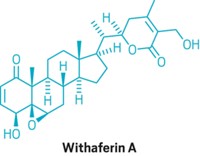Advertisement
Grab your lab coat. Let's get started
Welcome!
Welcome!
Create an account below to get 6 C&EN articles per month, receive newsletters and more - all free.
It seems this is your first time logging in online. Please enter the following information to continue.
As an ACS member you automatically get access to this site. All we need is few more details to create your reading experience.
Not you? Sign in with a different account.
Not you? Sign in with a different account.
ERROR 1
ERROR 1
ERROR 2
ERROR 2
ERROR 2
ERROR 2
ERROR 2
Password and Confirm password must match.
If you have an ACS member number, please enter it here so we can link this account to your membership. (optional)
ERROR 2
ACS values your privacy. By submitting your information, you are gaining access to C&EN and subscribing to our weekly newsletter. We use the information you provide to make your reading experience better, and we will never sell your data to third party members.
Biochemistry
Hormones reveal the secret life of fat cells
Understanding the slew of compounds produced by fat might one day lead to therapeutics for obesity-related conditions
by Jyoti Madhusoodanan, special to C&EN
October 6, 2018
| A version of this story appeared in
Volume 96, Issue 40

The first evidence that fat cells have a role beyond storing energy from excess food came from a strain of massively obese mutant mice. Before these mice, some researchers had suspected the cells were more than just a calorie cache. After all, obesity increases a person’s risk of type 2 diabetes, liver disease, high blood pressure, arthritis, and more. If an increase in fat mass is one of the greatest risk factors for these conditions, surely the cells that store that fat aren’t just innocent bystanders.
But it wasn’t until 1994, after years of sleuthing, that Jeffrey M. Friedman of Rockefeller University found definitive proof of fat cells’ secret lives: Those rotund mice were missing a peptide hormone named leptin (Nature 1994, DOI: 10.1038/372425a0). And that hormone was secreted by fat cells, also known as adipose cells. Without leptin to regulate their appetite, the animals were ravenous—and consequently grew nearly twice as large as control animals. “Leptin was the first hormone known to be secreted by fat that had a clear function, even in humans, and its absence caused a clear metabolic disorder,” endocrinologist Mitchell A. Lazar of the University of Pennsylvania says. “It really changed the world view to thinking of adipose tissue as an endocrine organ,” like a thyroid or an adrenal gland, which produces hormones.
Since then, researchers have uncovered dozens of previously unknown hormones churned out by fat cells, many with key metabolic roles in maintaining health or causing disease.
“It’s astonishing that to this day, we’re still discovering hormones that we didn’t know existed,” endocrinologist Brian J. Feldman of Stanford University says. “And they’re not just doing esoteric, small jobs—they have quite potent, major physiological implications.”
These new hormones offer targets for health treatments, particularly for obesity. The U.S. Food & Drug Administration approved leptin as a treatment for certain disorders of fat storage in 2014. Researchers hope that other newly discovered hormones from fat may lead to better treatments for obesity-linked hypertension, heart disease, and additional conditions. But first, they aim to learn how these hormones interact with well-known players, such as insulin, to incite metabolic changes.
Hidden sources
The term “hormone” was first formally used in 1905 by British physiologist Ernest Starling to describe a molecule that was secreted from one kind of cell and traveled through the bloodstream to act on other cells in distant parts of the body.
In the early 20th century, researchers had the tools to extract endocrine glands such as the pancreas, pulverize them, and prepare extracts. The hormones they isolated, such as insulin, were tested on dogs and then humans. The tests confirmed that organs in different parts of the body communicated via long-range chemical signals, and the results led to the use of insulin as a treatment for diabetes.
During the 1920s and 1930s, studying glandular extracts yielded several new hormones, including testosterone, estrogen, and adrenocorticotropic hormone—all with remarkable therapeutic uses.
But this line of discovery then stalled because studying hormones in this way required removing the key tissue, like the pancreas, from an animal and then adding back the molecule of interest to study its effects. If researchers were to look for hormones in other, more essential organs, such as the heart or lungs, or in tissues like fat that were everywhere in the body and therefore impossible to remove entirely, this technique wouldn’t work.
Today, newer methods have made it possible to look beyond endocrine glands for hormones. Advances in cell culture techniques have alleviated the need to crush up entire glands or organs to isolate molecules. Analyzing secreted proteins with mass spectrometry and tracking down the genes that encode them has enabled researchers to detect hormones released from bone, the kidneys, and other tissues. Fat has been a particularly fruitful source for mining new hormones.
For example, Lazar and his colleagues used RNA expression studies to discover a new fat-associated hormone in 2001. They were trying to figure out how a common group of antidiabetic medicines known as thiazolidinediones acted on different kinds of fat cells.
By comparing RNA levels in two kinds of fat cells—white and brown—in mice, Lazar’s team homed in on a protein produced by only white fat. White fat cells secreted the molecule as they matured; its levels then increased in animals with obesity and diabetes and dropped in response to the antidiabetic drugs. The researchers dubbed the molecule resistin because it appeared to mediate insulin resistance, the hallmark of diabetes (Nature 2001, DOI: 10.1038/35053000). Resistin’s sequence showed it was clearly a secreted protein that acted on other cells—the classic definition of a hormone. Lazar and colleagues were beyond excited “to have found a totally new hormone that was regulated by antidiabetic drugs,” Lazar recalls.
More recently, researchers at Baylor College of Medicine tracked down a hormone called asprosin by sequencing the genomes of people with a rare disorder resulting in abnormally low levels of body fat (Cell 2016, DOI: 10.1016/j.cell.2016.02.063). The researchers traced the cause to a genetic mutation that caused them to lack asprosin. People with obesity, they subsequently found, have higher levels of circulating asprosin.
Such clear-cut mutations are rare, but genomics is useful in other ways for hormone hunting. Genomics helps predict which proteins will be secreted, so mining genomic data sets can help identify possible hormones, says molecular biologist Katrin J. Svensson of Stanford University.
Svensson’s lab focuses on the molecules secreted from brown fat. While white fat seems to be mostly an energy-storage tissue, brown fat is highly metabolically active and efficient at burning calories, which keeps animals warm.
Because of brown fat’s high metabolism, Svensson says molecules identified in this tissue may have the potential to improve cells’ sensitivity to glucose, possibly offering leads in type 2 diabetes treatments. Using these genomic techniques to identify proteins secreted in brown fat, Svensson also identified Slit2-C, a protein that spurs glucose metabolism and energy expenditure (Cell Metab. 2016, DOI: 10.1016/j.cmet.2016.01.008).
The hormones secreted by brown fat “have the potential to be more beneficial rather than detrimental” in treating metabolic disorders, she says.
Nuanced roles
But it’s not enough to simply identify these new hormones from fat.

A growing body of evidence suggests that fat in different locations in the body acts differently—and secretes different hormones. And these hormones may mediate disparate links between an increase in fat cells—obesity—and the many health problems related to having too much fat. Scientists are attempting to understand these connections.
For example, although obesity has long been associated with an increased risk of hypertension, the precise link between the two has been a mystery. In 2013, researchers made a connection, finding that adipose tissue that collects around blood vessels in rodents secretes a hormone known as chemerin, which acts as a vasoconstrictor, raising blood pressure (Arterioscler., Thromb., Vasc. Biol. 2013, DOI: 10.1161/atvbaha.113.301476).
Feldman and his team at Stanford have also found that mature fat cells secrete a hormone named ADAMTS1, which instructs fat stem cells to mature and prepare to store the energy from excess food (Sci. Signaling 2016, DOI: 10.1126/scisignal.aag0487). In addition, they found that ADAMTS1 acts differently in different fat depots: In mice fed a high-fat diet, ADAMTS1 leads to accumulation of visceral fat, the kind that builds up around internal organs, but prevents fat stem cells from maturing and storing fat under the skin.
While studying ADAMTS1, researchers made an important link. The hormone is made not only in fat tissue but also in immune cells known as macrophages within muscle, where it helps with repair after an injury (Nat. Commun. 2017, DOI: 10.1038/s41467-017-00522-7). Previously, researchers similarly found that it was macrophages—not white fat cells—that produced resistin in humans (Diabetes 2001, DOI: 10.2337/diabetes.50.10.2199).
Secret no more
Here are some of the many hormones produced by fat cells in humans and in mice, along with the year they were discovered and their different functions.
Leptin (1994): Regulates appetite
Adiponectin (1995): Increases insulin sensitivity, reduces inflammation
ADAMTS1 (1997): Influences fat stem cell differentiation, blood vessel formation, ovulation
Chemerin (1997): Increases inflammation, raises blood pressure
Resistin (2001): Mediates resistance to insulin
Retinol-binding protein 4 (2005): Implicated in insulin resistance
Lipocalin-2 (2007): Increases insulin resistance and inflammation
Isthmin-1 (2014): Improves fat metabolism in the liver, mediates immune system, influences developmental patterning
Asprosin (2016): Modulates glucose release from the liver
Slit2-C (2016): Spurs glucose metabolism
Lipocalin-5 (2018): Enhances skeletal muscle respiration
Obesity causes an inflammatory reaction that may be a potential trigger for certain weight-related conditions, such as arthritis or diabetes. So the finding that macrophages produce ADAMTS1 in injured muscles “may in some way be similar to the inflammatory response in adipose tissue in response to obesity,” Feldman says.
Taken together, chemerin, ADAMTS1, and other fat-associated hormones could point the way toward an explanation for a common medical observation: that visceral fat is more likely than subcutaneous fat to cause diabetes or metabolic disease.
Molecules such as ADAMTS1 and resistin also strengthen the idea of a link between fat hormones and inflammation and may help researchers understand “the nexus of inflammation and obesity,” Lazar says.
Connecting the dots
With each new hormone discovered comes the promise of a new route to treat obesity or obesity-related conditions. But it’s still too early to tell which hormones will yield definite therapies. So far, leptin is the only fat-cell-secreted hormone to have reached clinical use.
Advertisement
Lazar recalls the excitement of discovering resistin, which came a few years after leptin’s groundbreaking discovery. “We were remarkably optimistic that it would be a drug target for diabetes,” he says. But because it is actually secreted by macrophages and not fat cells in humans, and the identity of the receptor that it binds to is still unclear, resistin has yet to find its clinical footing. Similarly, the receptors for many other hormones are unknown, and the full extent of their functions remains murky.
“You cannot truly understand the pathways a molecule regulates until you have its receptor,” Svensson says. “That’s the key to understanding a signaling system and to determining whether these are feasible therapeutic targets.”
Nonetheless, the data so far indicate that the new fat-associated hormones may be critical players in specific aspects of obesity-linked diseases. For example, high levels of resistin have been correlated with an increased risk of heart disease and insulin resistance in a large human population. An ongoing clinical study aims to assess whether asprosin mediates a common but deadly complication of diabetes.
Understanding how these molecules work could explain why not everyone who is overweight develops the same problems—for example, why some overweight people have diabetes or heart disease, while others, often called “fat but fit,” remain obese but suffer no ill effects.
Individual differences in expression of these hormones—a person’s “fingerprint” of molecules secreted by fat cells—might help explain these nuances, Lazar says. And as we understand their precise roles, it is possible that “in some cases, these hormones may have effects that could really be targeted to improve quality of life.”

Jyoti Madhusoodanan is a freelance writer. A version of this story first appeared in ACS Central Science: cenm.ag/fathormones.





Join the conversation
Contact the reporter
Submit a Letter to the Editor for publication
Engage with us on Twitter